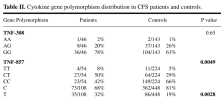A first study of cytokine genomic polymorphisms in CFS: Positive association of TNF-857 and IFNgamma 874 rare alleles
N Carlo-Stella, C Badulli, A De Silvestri, L Bazzichi, M Martinetti, L Lorusso, S Bombardieri, L Salvaneschi, M Cuccia
Published: 2006
[Line breaks added]
Objective
In the past two years we have developed a biological bank of genomic DNA, cDNA, serum and red blood cells of Italian patients with certified CFS from the two Italian referral centers for the syndrome. Recent studies have shown an imbalance in cytokine production in disease states similar to Chronic Fatigue Syndrome (CFS), such as sickness behavior, both in animals and in humans. However we notice that serum cytokine concentrations are often inconstant and degrade rapidly.
With this in mind, we investigated cytokine gene polymorphisms in 80 Italian patients with CFS in order to ascertain whether in this group of patients it is possible to describe a genetic predisposition to an inflammatory response.
Methods
We analyzed the promoter polymorphisms of IL-10, IL-6 and the IFNgamma 874 T/A polymorphism in intron 1 with a PCR-SSP method (Cytogen One Lambda Inc. Canoga Park, CA, U.S.A) in 54 patients and TNF-308 G/A and -857 C/T promoter polymorphisms with a PCR-RFLP method (in 54 and 80 patients respectively).
Results
There is a highly significant increase of TNF -857 TT and CT genotypes (p = 0.002) among patients with respect to controls and a significant decrease of IFN gamma low producers (A/A) (p = 0.04) among patients with respect to controls.
Conclusions
We hypothesize that CFS patients can have a genetic predisposition to an immunomodulatory response of an inflammatory nature probably secondary to one or more environmental insults of unknown nature.
Web | PDF | Clinical and Experimental Rheumatology | Open Access
N Carlo-Stella, C Badulli, A De Silvestri, L Bazzichi, M Martinetti, L Lorusso, S Bombardieri, L Salvaneschi, M Cuccia
Published: 2006
[Line breaks added]
Objective
In the past two years we have developed a biological bank of genomic DNA, cDNA, serum and red blood cells of Italian patients with certified CFS from the two Italian referral centers for the syndrome. Recent studies have shown an imbalance in cytokine production in disease states similar to Chronic Fatigue Syndrome (CFS), such as sickness behavior, both in animals and in humans. However we notice that serum cytokine concentrations are often inconstant and degrade rapidly.
With this in mind, we investigated cytokine gene polymorphisms in 80 Italian patients with CFS in order to ascertain whether in this group of patients it is possible to describe a genetic predisposition to an inflammatory response.
Methods
We analyzed the promoter polymorphisms of IL-10, IL-6 and the IFNgamma 874 T/A polymorphism in intron 1 with a PCR-SSP method (Cytogen One Lambda Inc. Canoga Park, CA, U.S.A) in 54 patients and TNF-308 G/A and -857 C/T promoter polymorphisms with a PCR-RFLP method (in 54 and 80 patients respectively).
Results
There is a highly significant increase of TNF -857 TT and CT genotypes (p = 0.002) among patients with respect to controls and a significant decrease of IFN gamma low producers (A/A) (p = 0.04) among patients with respect to controls.
Conclusions
We hypothesize that CFS patients can have a genetic predisposition to an immunomodulatory response of an inflammatory nature probably secondary to one or more environmental insults of unknown nature.
Web | PDF | Clinical and Experimental Rheumatology | Open Access



